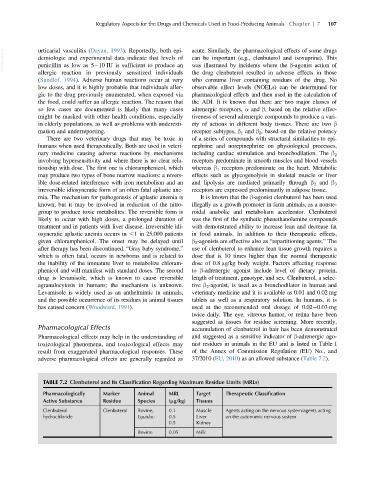Page 140 - Veterinary Toxicology, Basic and Clinical Principles, 3rd Edition
P. 140
Regulatory Aspects for the Drugs and Chemicals Used in Food-Producing Animals Chapter | 7 107
VetBooks.ir urticarial vasculitis (Dayan, 1993). Reportedly, both epi- acute. Similarly, the pharmacological effects of some drugs
can be important (e.g., clenbuterol and isoxuprine). This
demiologic and experimental data indicate that levels of
penicillin as low as 5 10 IU is sufficient to produce an
was illustrated by incidents where the β-agonist action of
allergic reaction in previously sensitized individuals thedrugclenbuterol resultedinadverse effectsinthose
(Sundlof, 1994). Adverse human reactions occur at very who consume liver containing residues of the drug. No
low doses, and it is highly probable that individuals aller- observable effect levels (NOELs) can be determined for
gic to the drug previously enumerated, when exposed via pharmacological effects and then used in the calculation of
the food, could suffer an allergic reaction. The reason that the ADI. It is known that there are two major classes of
so few cases are documented is likely that many cases adrenergic receptors, α and β, based on the relative effec-
might be masked with other health conditions, especially tiveness of several adrenergic compounds to produce a vari-
in elderly populations, as well as problems with underesti- ety of actions in different body tissues. There are two β
mation and underreporting. receptor subtypes, β 1 and β 2 , based on the relative potency
There are two veterinary drugs that may be toxic in of a series of compounds with structural similarities to epi-
humans when used therapeutically. Both are used in veteri- nephrine and norepinephrine on physiological processes,
nary medicine causing adverse reactions by mechanisms including cardiac stimulation and bronchodilation. The β 2
involving hypersensitivity and where there is no clear rela- receptors predominate in smooth muscles and blood vessels
tionship with dose. The first one is chloramphenicol, which whereas β 1 receptors predominate on the heart. Metabolic
may produce two types of bone marrow reactions: a revers- effects such as glycogenolysis in skeletal muscle or liver
ible dose-related interference with iron metabolism and an and lipolysis are mediated primarily through β 2 and β 3
irreversible idiosyncratic form of an often fatal aplastic ane- receptors are expressed predominantly in adipose tissue.
mia. The mechanism for pathogenesis of aplastic anemia is It is known that the β-agonist clenbuterol has been used
known, but it may be involved in reduction of the nitro- illegally as a growth promoter in farm animals, as a nonste-
group to produce toxic metabolites. The reversible form is roidal anabolic and metabolism accelerator. Clenbuterol
likely to occur with high doses, a prolonged duration of was the first of the synthetic phenethanolamine compounds
treatment and in patients with liver disease. Irreversible idi- with demonstrated ability to increase lean and decrease fat
osyncratic aplastic anemia occurs in ,1 in 25,000 patients in food animals. In addition to their therapeutic effects,
given chloramphenicol. The onset may be delayed until β 2 -agonists are effective also as “repartitioning agents.” The
after therapy has been discontinued. “Gray baby syndrome,” use of clenbuterol to enhance lean tissue growth requires a
which is often fatal, occurs in newborns and is related to dose that is 10 times higher than the normal therapeutic
the inability of the immature liver to metabolize chloram- dose of 0.8 μg/kg body weight. Factors affecting response
phenicol and will manifest with standard doses. The second to β-adrenergic agonist include level of dietary protein,
drug is levamisole, which is known to cause reversible length of treatment, genotype, and sex. Clenbuterol, a selec-
agranulocytosis in humans; the mechanism is unknown. tive β 2 -agonist, is used as a bronchodilator in human and
Levamisole is widely used as an anthelmintic in animals, veterinary medicine and it is available as 0.01 and 0.02 mg
and the possible occurrence of its residues in animal tissues tablets as well as a respiratory solution. In humans, it is
has caused concern (Woodward, 1991). used at the recommended oral dosage of 0.02 0.03 mg
twice daily. The eye, vitreous humor, or retina have been
suggested as tissues for residue screening. More recently,
Pharmacological Effects accumulation of clenbuterol in hair has been demonstrated
Pharmacological effects may help in the understanding of and suggested as a sensitive indicator of β-adrenergic ago-
toxicological phenomena, and toxicological effects may nist residues in animalsinthe EU andislistedinTable I
result from exaggerated pharmacological responses. These of the Annex of Commission Regulation (EU) No., and
adverse pharmacological effects are generally regarded as 37/2010 (EU, 2010)asanallowedsubstance (Table 7.2).
TABLE 7.2 Clenbuterol and Its Classification Regarding Maximum Residue Limits (MRLs)
Pharmacologically Marker Animal MRL Target Therapeutic Classification
Active Substance Residue Species (μg/kg) Tissues
Clenbuterol Clenbuterol Bovine, 0.1 Muscle Agents acting on the nervous system/agents acting
hydrochloride Equidae 0.5 Liver on the autonomic nervous system
0.5 Kidney
Bovine 0.05 Milk

